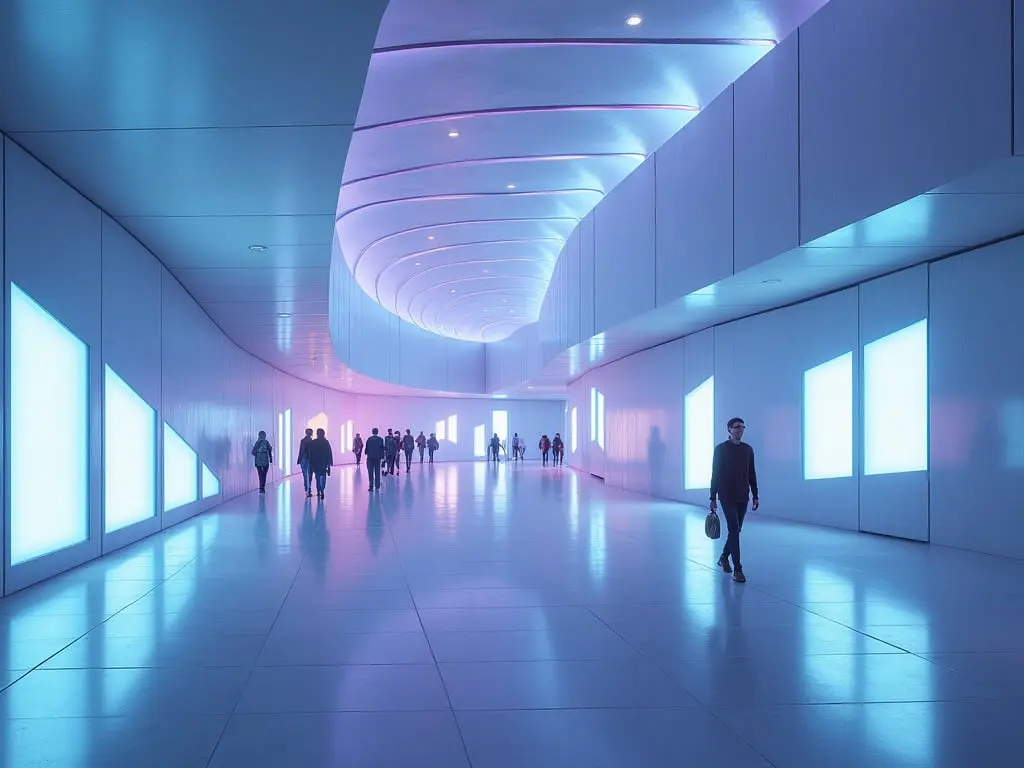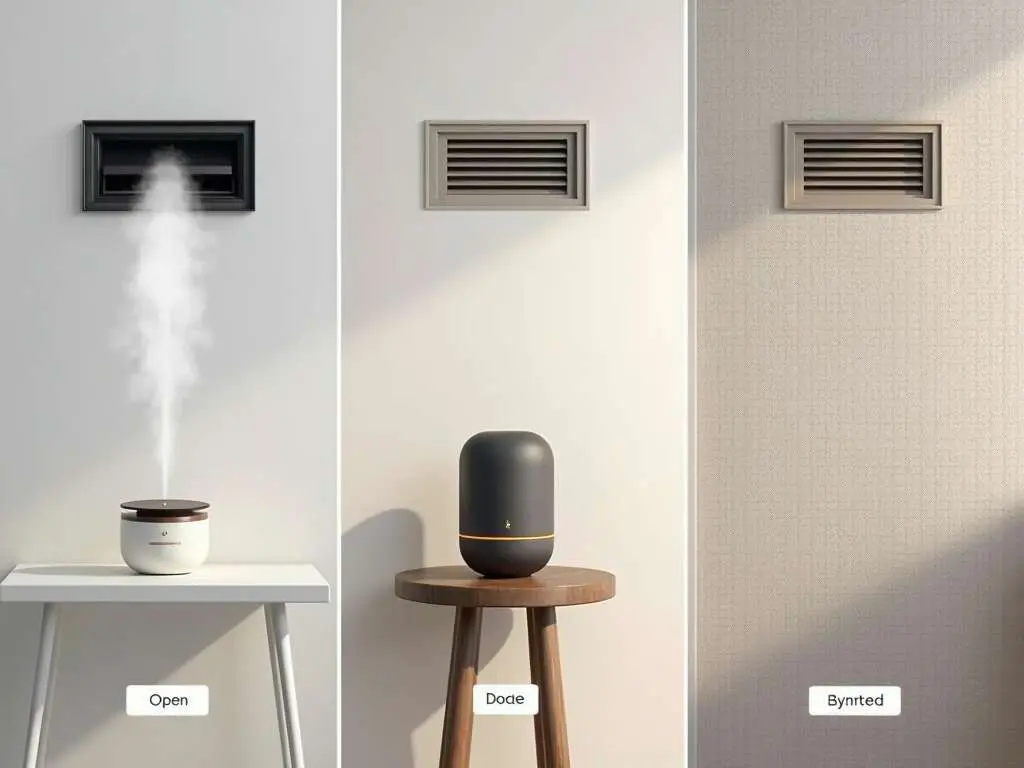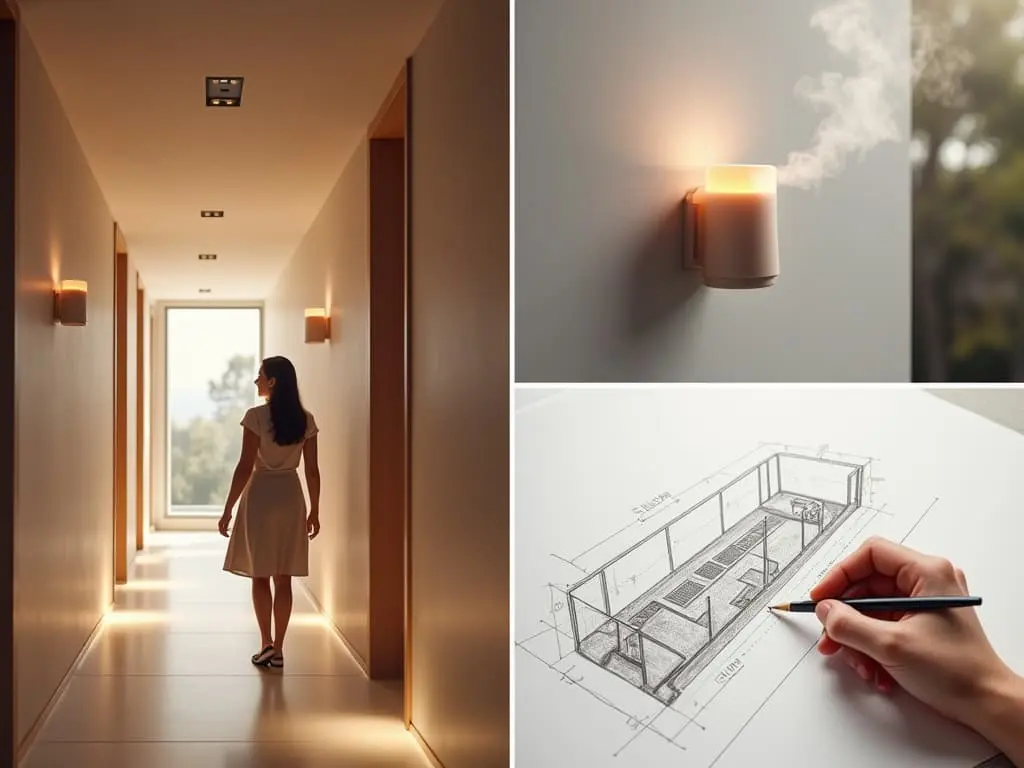As a sensory design expert with a passion for transforming overlooked spaces, I’m thrilled to explore the fascinating world of scent corridors. At Curvspace, we’re always seeking innovative ways to elevate interior experiences, and fragrance design in hallways is a game-changer. Join me as we delve into this aromatic revolution that’s redefining how we perceive and interact with transitional spaces in our homes and buildings.
Jump to:
The Rise of Olfactory Architecture
Imagine walking through a hallway that not only looks beautiful but engages your senses on a deeper level. That’s the promise of scent corridors – a cutting-edge approach to interior design that’s capturing the imagination of architects and homeowners alike.
Scent corridors leverage the power of fragrance to transform mundane passageways into multi-sensory experiences. By strategically incorporating aromas, designers can evoke emotions, trigger memories, and even influence behavior as people move through a space.
But why focus on hallways specifically? As transitional areas, hallways present a unique opportunity to create a sensory journey between different rooms or floors. A well-designed scent corridor can:
- Set the mood as you enter a home or building
- Provide subtle wayfinding cues
- Mask unpleasant odors
- Enhance the perceived quality of a space
- Create a memorable, branded experience
Let’s explore how this olfactory revolution is unfolding and how you can incorporate scent design into your own projects.
The Science Behind Scent Design
To understand the power of scent corridors, we need to dive into the fascinating world of olfactory science. Our sense of smell is intimately connected to the limbic system – the part of our brain responsible for emotions and memories. This is why certain scents can instantly transport us back to childhood or evoke powerful feelings.
Key facts about our sense of smell:
- Humans can distinguish between 1 trillion different odors
- Scent memories are more vivid and emotional than visual memories
- Our olfactory receptors are replaced every 4-8 weeks, allowing for ongoing sensitivity
Scent designers leverage this powerful sensory channel to create immersive, emotionally resonant experiences. By carefully selecting and combining fragrances, they can:
- Influence mood (e.g. lavender for relaxation, citrus for energy)
- Enhance cognitive performance
- Reduce stress and anxiety
- Improve perceived air quality
- Create a sense of place and brand identity
Implementing Scent Corridors: Techniques and Technologies

Now that we understand the “why” behind scent corridors, let’s explore the “how.” Implementing an effective scent design requires careful planning and the right technology. Here are some key considerations:
Scent Diffusion Methods
- HVAC Integration: Fragrance is introduced directly into the ventilation system for even, widespread distribution.
- Standalone Diffusers: Strategically placed devices that release scent at timed intervals.
- Scented Materials: Incorporating aromatic elements into building materials or decor (e.g. scented paint, fragrant wood).
- Nebulization: Ultra-fine scent particles are dispersed as a dry mist for a subtle effect.
Scent Zoning and Layering
Creating an effective scent corridor often involves more than just a single fragrance. Consider:
- Scent Transitions: Gradually shifting from one aroma to another as you move through the space.
- Intensity Gradients: Varying the strength of the scent to create depth and interest.
- Complementary Fragrances: Combining scents that work well together for a harmonious experience.
Smart Scenting Technology
The latest scent diffusion systems offer advanced features like:
- IoT Integration: Control and monitor scent levels remotely via smartphone apps.
- Occupancy Sensors: Adjust scent output based on the number of people in the space.
- Dayparting: Automatically change fragrances throughout the day to match different moods or activities.
Benefits of Scent Corridors
The implementation of scent corridors offers a wide range of benefits for both residential and commercial spaces:
- Enhanced User Experience: Creating a multi-sensory journey that delights and engages.
- Improved Wayfinding: Subtle scent cues can guide people through complex buildings.
- Stress Reduction: Calming fragrances can ease anxiety in high-traffic areas.
- Brand Reinforcement: A signature scent becomes part of a company’s identity.
- Increased Perceived Value: Well-scented spaces are often perceived as higher quality.
- Improved Air Quality: Many scent systems also purify the air, removing odors and pollutants.
- Energy Efficiency: Some fragrances can make spaces feel warmer or cooler, potentially reducing HVAC costs.
Popular Fragrance Choices for Hallways

When designing a scent corridor, choosing the right fragrances is crucial. Here are some popular options and their potential effects:
- Lavender: Calming and relaxing, ideal for residential spaces or spa-like environments.
- Citrus (Lemon, Orange): Energizing and uplifting, great for office buildings or schools.
- Vanilla: Comforting and familiar, works well in hotels or retail spaces.
- Pine or Cedar: Fresh and natural, perfect for creating an outdoor feel indoors.
- Ocean Breeze: Clean and refreshing, suitable for coastal properties or wellness centers.
Remember, the key is to choose scents that align with the overall design aesthetic and intended mood of the space. Don’t be afraid to experiment with unique combinations or custom-blended fragrances to create a truly signature experience.
Case Studies: Scent Corridors in Action
Let’s look at some real-world examples of how scent corridors are being implemented:
1. The Westin Hotel Chain
The Westin has developed a signature “White Tea” scent that’s used in their lobbies and hallways worldwide. This consistent olfactory branding creates a sense of familiarity and luxury for guests, no matter which location they visit.
2. Abercrombie & Fitch Stores
While controversial, A&F’s use of their signature “Fierce” cologne throughout their retail spaces, including hallways, has become an integral part of their brand identity. The scent is so closely associated with the brand that many customers can identify an A&F store by smell alone.
3. Singapore Changi Airport
This award-winning airport uses different scents in various zones to create a more pleasant travel experience. Lavender and citrus scents in arrival halls help combat jet lag, while floral fragrances in gardens and retail areas enhance the tropical atmosphere.

Challenges and Considerations
While scent corridors offer exciting possibilities, there are some challenges to consider:
- Sensitivities and Allergies: Some individuals may be sensitive to certain fragrances. It’s important to use hypoallergenic scents and provide fragrance-free zones when possible.
- Cultural Differences: Scent preferences can vary widely across cultures. Research your target audience to ensure your fragrance choices resonate positively.
- Overuse: Too much fragrance can be overwhelming. Aim for subtle, barely perceptible scents rather than overpowering aromas.
- Maintenance: Scent systems require regular upkeep and refills to maintain consistent performance.
- Integration with Other Design Elements: Scent should complement, not compete with, visual and tactile design elements.
The Future of Scent Design

As technology advances, we can expect to see even more innovative applications of scent in interior design:
- Personalized Scent Experiences: AI-powered systems that adjust fragrances based on individual preferences or biometric data.
- Interactive Scent Installations: Art pieces or displays that release scents in response to touch or movement.
- Scent-Enhanced Virtual Reality: Combining olfactory stimuli with VR for truly immersive experiences.
- Therapeutic Scent Design: Using precisely calibrated fragrances for specific health benefits in healthcare settings.
The possibilities are truly endless, and I can’t wait to see how designers and architects continue to push the boundaries of sensory design.
People Also Ask
Q1: Are scent corridors safe for people with allergies or sensitivities?
A: While many modern scent systems use hypoallergenic fragrances, it’s important to consider potential sensitivities. Best practices include using subtle scents, providing fragrance-free zones, and clearly communicating the presence of scented areas.
Q2: How much does it cost to implement a scent corridor system?
A: Costs can vary widely depending on the size of the space, the complexity of the system, and the quality of fragrances used. Basic standalone diffusers can start around $100, while comprehensive HVAC-integrated systems for large buildings can cost tens of thousands of dollars.
Q3: Can I create a DIY scent corridor in my home?
A: Absolutely! While professional systems offer more control and consistency, you can experiment with home diffusers, scented candles, or even natural elements like fresh herbs or flowers to create your own scented pathways.
Conclusion
Scent corridors represent an exciting frontier in interior design, offering a powerful way to enhance spaces and create memorable experiences. By engaging our often-overlooked sense of smell, we can transform mundane hallways into sensory journeys that delight, guide, and inspire. As this field continues to evolve, I encourage you to explore the possibilities of olfactory design in your own projects.
References
1 Spence, C. (2020). Using ambient scent to enhance well-being in the multisensory built environment. Frontiers in Psychology, 11, 598859.
2 Herz, R. S. (2016). The role of odor-evoked memory in psychological and physiological health. Brain Sciences, 6(3), 22.
3 Goldkuhl, L., & Styvén, M. (2007). Sensing the scent of service success. European Journal of Marketing, 41(11/12), 1297-1305.
Disclosure
Our content is reader-supported. This means if you click on some of our links, then we may earn a commission. Commissions do not affect our editor’s opinions or evaluations. Learn more about our editorial process.

About the Editorial Staff
The Curvspace editorial team comprises a diverse group of experts on intermediate and threshold spaces in homes and workplaces. Architects and interior designers, civil engineers and artists, environmental and behavioral psychologists, sociologists and anthropologists. All collaborate to create helpful content, that explores the full potential of these often-overlooked areas to enhance our daily lives.


